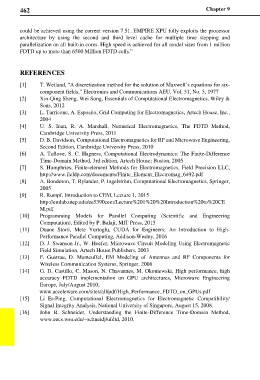Page 482 - Maxwell House
P. 482
462 Chapter 9
could be achieved using the current version 7.51. EMPIRE XPU fully exploits the processor
architecture by using the second and third level cache for multiple time stepping and
parallelization on all built-in cores. High speed is achieved for all model sizes from 1 million
FDTD up to more than 6500 Million FDTD cells.”
REFERENCES
[1] T. Weiland, “A discretization method for the solution of Maxwell’s equations for six-
component fields,” Electronics and Communications AEU, Vol. 31, No. 3, 1977
[2] Xin-Qing Sheng, Wei Song, Essentials of Computational Electromagnetics, Wiley &
Sons, 2012
[3] L. Tarricone, A. Esposito, Grid Computing for Electromagnetics, Artech House, Inc.,
2004
[4] U. S. Inan, R. A. Marshall, Numerical Electromagnetics, The FDTD Method,
Cambridge University Press, 2011
[5] D. B. Davidson, Computational Electromagnetics for RF and Microwave Engineering,
Second Edition, Cambridge University Press, 2010
[6] A. Taflove, S. C. Hagness, Computational Electrodynamics: The Finite-Difference
Time-Domain Method, 3rd edition, Artech House; Boston, 2005
[7] S. Humphries, Finite-element Methods for Electromagnetics, Field Precision LLC,
http://www.fieldp.com/documents/Finite_Element_Electromag_6492.pdf
[8] A. Bondeson, T. Rylander, P. Ingelström, Computational Electromagnetics, Springer,
2005
[9] R. Rumpf, Introduction to CEM, Lecture 1, 2015
http://emlab.utep.edu/ee5390cem/Lecture%201%20%20Introduction%20to%20CE
M.pdf
[10] Programming Models for Parallel Computing (Scientific and Engineering
Computation), Edited by P. Balaji, MIT Press, 2015
[11] Duane Storti, Mete Yurtoglu, CUDA for Engineers: An Introduction to High-
Performance Parallel Computing, Addison-Wesley, 2016
[12] D. J. Swanson Jr., W. Hoefer, Microwave Circuit Modeling Using Electromagnetic
Field Simulation, Artech House Publishers, 2003
[13] F. Gustrau, D. Manteuffel, EM Modeling of Antennas and RF Components for
Wireless Communication Systems, Springer, 2006
[14] G. D. Castillo, C. Mason, N. Chavannes, M. Okoniewski, High performance, high
accuracy FDTD implementation on GPU architectures, Microwave Engineering
Europe, July/August 2010,
www.acceleware.com/sites/all/pdf/High_Performance_FDTD_on_GPUs.pdf
[15] Li Er-Ping, Computational Electromagnetics for Electromagnetic Compatibility/
Signal Integrity Analysis, National University of Singapore, August 15, 2008.
[16] John B. Schneider, Understanding the Finite-Difference Time-Domain Method,
www.eecs.wsu.edu/~schneidj/ufdtd, 2010.

